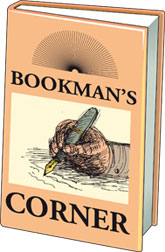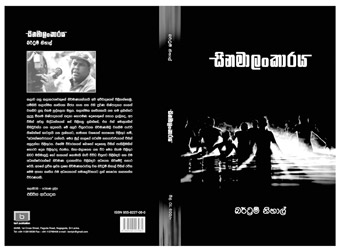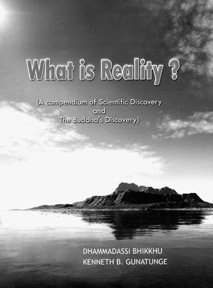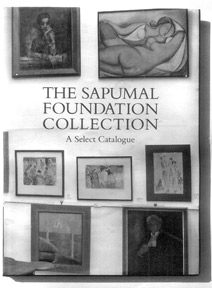
Rare tome on cinema
Reviewed by Kalakeerthi Edwin Ariyadasa
For several decades now, Bertram Nihal has been travelling Third
Class, while possessing a Super Grade Ticket. His oeuvre of work
particularly in the medium of teledrama, has established a norm, that is
clearly difficult to be reached or surpassed.
Some of his creative efforts in this field are landmarks in the
tradition of Sri Lankan teledrama. His serialized teledrama "Gamperaliya",
(scripted by Tissa Abeysekera) set up a record for the reconstruction of
a historical period, through assiduous and painstaking research. Quite
astonishingly, the youthful creative zest, keenness and the commitment
he displayed then, has remained undiminished throughout the years.
 Several teledramas later, Bertram Nihal presented his serialized
teleplay "Bhavana" (Meditation) to the world. It won mass approval and
critical acclaim. Several teledramas later, Bertram Nihal presented his serialized
teleplay "Bhavana" (Meditation) to the world. It won mass approval and
critical acclaim.
With many others, who thought like me, I promptly concluded at that
time, that this must be the last word in Sri Lankan teledrama.
But, not any more.
I have seen his latest teledrama "Amarapuraya" (The Immortal city).
If you view it, you will undoubtedly aver in unison with me, that there
could hardly be any other future Sinhala teledrama, that could scale a
peak higher than what 'Amarapuraya' has achieved.
There is, of course, a hitch. Amarapuraya has not been publicly
screened yet. It is a vast pity, that, the viewer-masses have been
deprived of the opportunity to see what could probably be the greatest
teledrama made in Sinhala in Sri Lanka, so far.
At this point, you may very well wonder, whether I am digressing. How
about the book-review? All what I said above, is an approach to this
central issue of looking at Bertram Nihal's latest tome.
Almost all his teledrama successes are the inevitable outcome of his
obsessive preoccupation with perfectionism. As author, he transfers this
trait to his writings.
He could be given the middle-name 'Perfectionist', to reflect this
impressive personality asset.
The latest literary work by Bertram 'Perfectionist' Nihal, is a
thorough study, the avowed purpose of which, is to conjugate the grammar
of cinema, comprehensively. His title for this seminal work is 'Cinemalankaraya'
(The Glory of Cinema).
Some of those persons, who feel unhappy if they cannot classify,
categorize or label a given work, will experience a marked frustration,
when they deal with Bertram Nihal's 'Cinemalankaraya.' It is not a
history of the film. Nor is it an attempt to delve deep into the
aesthetics of cinema.
Its style is not directly didactic either. On the other hand, it is a
synthesis of all those elements - and much more.
Defining what he sets out to do in his book, the author says, that it
is an analysis of the Renaissance of world cinema tracing the path it
has trodden up to now.
His purpose is so widely scooped, that no run of the mill author,
will have anything to do with such an ambitious book-project. But,
Bertram Nihal not only plunges into it head-long, but emerges from the
escapade triumphant and unscathed.
The detail, that fills page after page of his book, inspires awe and
admiration. The pleasantly bewildered use of this book may question in
astonished disbelief. "How on earth did this man gather and manage all
this world of material?"
The total work is an imposing monument to his impressive capacity for
sustained concentration and fully focussed writing.
Anyone going through his work will readily grant that this man is a
working and living embodiment of patience.
To judge from the finished product, he must have spent hours and days
on end, refining a phrase or constructing a paragraph.
His chapters one and two are dedicated to the analysis of cinema and
art. He presents to his readers an analysis of what art is, in a simple
but in-depth discourse.
The sources he quotes, have such a wide range in time and clime, that
the work assumes the guise of a mini-encylopedia.
The formal history of world cinema extends over a period of about 115
years. Bertram Nihal uses many outstanding cinematic creations,
throughout history, to make his point.
To cull illustrations for his theoretical statements, Bertram Nihal
resorts, not only to a vast swath of film but also to views expressed by
critics, men of cinema and others who are eminent in various fields.
One could very well state, that Bertram Nihal's work is a Sinhala
compendium of the love associated with the medium of cinema.
Indigenous cinema - the tradition of Sinhala film - making, to be
specific has a history of 63 years. This period has seen the creation of
a vast variety of films, of different calibre. But at no time, during
this history has there been any authoritative discussion, dialogue or
discourse on the aesthetics and the techniques of cinema of an elevated
level.
I am fully aware, as a pioneer in the introduction of cinema teaching
at higher education level in Sri Lanka, 47 years ago, that in-depth
instructions in issues relating to cinema, have been few and far
between.
If a dialogue was attempted on the theory of techniques and
technologies it would lack a concentration on the aesthetics of cinema.
This is applicable vice versa as well. This hiatus gives a
significant edge to the stature of Bertram Nihal's book. The scope and
the perspective of his work are in a manner of speaking - all embracing.
The directorial talent, film-aesthetics, thespian elements and the
ordinary filmgoer will all have something worthwhile to derive from this
book.
This work could immediately serve as an indispensable vade mecum for
those who are required to possess an in-depth awareness of the film
medium. This is an ideal text-book material for all students at higher
levels and for all those whose interest in cinema is profound. A
practical problem Bertram Nihal has had quite obviously to grapple with
is the vocabulary. In Sri Lanka we do not have the Sinhala terminology,
that would enable people to indulge in a worthwhile discussion on
cinema. In his comprehensive and substantial work, Bertram Nihal has
evolved his own solution. Some of the Sinhala expressions occurring in
his work are the technical terms Bertram Nihal himself created.
When you peruse Bertram Nihal's tome, you cannot help but feel that
there is hardly any aspect of cinema, he has left untouched.
The author, wholesomely nourishes the reader even in the two
appendices he tags on to the main menu. In one he provides a useful
bibliography. The other is a partial listing of some of the most
significant films in the global history of cinema.
Betram Nihal's valued tome is so thoroughly exalted, that even the
most objective writer assessing it, invariably runs a risk. Some may
turn round, and say "hyperbole." But, the response to such a charge is
quite simple "Read it for yourself".
If those who are in the right positions, assigned to promote art and
culture, do not recognize Bertram Nihal's unprecedented contribution
here, to the on-going discourse on art and culture in Sri Lanka it can
be thought of only as a vast pity.
"Cinemalankaraya" is, in effect a scintillating glory to Simhala
literature on this culture - transforming discipline - cinema.
Fascinating presentation on reality
Reviewed by R. S. Karunaratne
What is reality? This is a highly philosophical question. The book
answers this most important question irrespective of creed, faith or
deeply imbedded beliefs and prejudices in us.
The book has two parts. In part one, the reader is taken through a
highly fascinating world of scientific discoveries related to our world
and the universe at large. After a brief but comprehensive description
of the main components of the universe, the authors introduce the reader
to the most advanced and modern scientific theories, observations and
findings related to the topic of reality.
 In the process, the authors unravel the mysteries of not only the
universe, but also the hidden microscopic world of the basic blocks of
matter that everything in us and outside us is built on. The authors
exploit advanced and sophisticated theories that need complex
mathematics. However, no mathematical or scientific background is needed
since everything in the presentation is explained in such a way that any
ordinary person can understand the text easily. In the process, the authors unravel the mysteries of not only the
universe, but also the hidden microscopic world of the basic blocks of
matter that everything in us and outside us is built on. The authors
exploit advanced and sophisticated theories that need complex
mathematics. However, no mathematical or scientific background is needed
since everything in the presentation is explained in such a way that any
ordinary person can understand the text easily.
We have a reasonable idea of matter in the form of the trees, the
mountains. and the earth with all its contents including our bodies.
But, then, what is Dark Matter? What is Dark Energy? And, what are Black
Holes with enormous densities residing in colossal form out there in the
universe that display the most bizarre and unbelievably mysterious
characteristics?
Why do scientists find that these three unknown features totally
control the destiny of our universe? Through the pages of part one, the
reader will come to know about them all without involving too much of
intellectual fervour.
In the early part of the last century Albert Einstein discovered that
the universe is expanding, demolishing the commonly held view that it is
totally static lying there for ever in the present form. This discovery
created the greatest upheaval in the scientific and the religious
community of the day. Then, a series of questions arise. If the universe
is expanding then where is it expanding into? From where did the
universe begin its expansion? Then came to light the most daunting
aspect of the expanding universe. If the universe is expanding, then
what is the beginning of the universe? That is to ask: What is the
origin of the universe? Then comes the Big Bang: the theory of the
origin of the universe.
The authors take the reader through a highly gainful and fascinating
journey, finding answers to those questions, through the discoveries the
scientists have made unravelling the mysteries of universe. In the
process the scientists have discovered to their utmost surprise that the
reality is not what everybody including them thought it to be. The
common sense based view of reality we all share has to be discarded,
although grudgingly. In other words, our view of the world is not
really, real!
Scientists looked at the microscopic world, which is inside the tiny
atom with which all matter is made of, in minutest possible detail too.
The discoveries made here were absolutely shocking even to scientists.
What lies inside the atom are called subatomic particles that can be
regarded as the most fundamental building blocks of matter.
The behaviour of these subatomic particles was a shocking revelation
to scientists that the world is not what we assume it to be. The
scientists' world of reality was turned upside down by their own
discoveries. What then, is the ultimate reality the scientists
discovered? The reader can discover this reality, by reading the book.
In part two, the readers are taken through the most interesting
discoveries of the Buddha. Here again, the journey one makes through the
pages of part two is full of revelations never known to mankind before
the Buddha. The Buddha made his discoveries over 2500 years ago, yet
they are equally shocking as the scientific ones to us, even today. The
reality the Buddha discovered so long ago glaringly displays a "world
view" that totally contradicts the one we are used to. The authors
elucidate on the deepest aspects of Buddha, Dhamma quite lucidly, so
that the reader may gain substantial knowledge without undue effort. The
authors show through step by step presentation, how the Buddha took the
'being' apart into its minutest possible components and examined them
microscopically revealing the innermost secrets in them. The reality the
Buddha discovered is opened in the pages of this book for the keen
reader.
As the authors claim, this is not a book on science nor one on
Buddhism. This is a fascinating presentation on reality. The reality
discovered through the most advanced scientific investigation and that
discovered by the Buddha's research are presented side by side in this
book.
This is not a book that advocates any religious faith and hence it
may appeal to everybody whatever the faith, whatever the present view of
reality they have embraced. The presentation is lucid, easy to read and
creates a curiosity running across the chapters in such way that you may
hasten to move over to the next chapter when one is completed.
The book available at leading bookshops most certainly ignites the
flame of enquiry into the topic of reality in a remarkable way.
Urban agriculture for reducing poverty and malnutrition
Reviewed by Athauda Jayawardena
"Manual of Low/No-Space Agriculture -cum- Family Business Gardens"
written and recently launched by Dr. Thilak T. Ranasinghe was
significant in two ways. It is timely and relevant in the context of the
efforts that are being made by developing countries to achieve the
Millennium Development Goals adopted by the United Nations in 2000.
Sri Lanka is one of the 147 member countries signed to achieve the
Millennium Development Goals by the year 2025. As it is well known, 50%
of these goals have to be achieved by the year 2015. Of these 8
Millennium Development Goals identified the first one is the Eradication
of Poverty and Hunger.In our country close to about 50% of the
population suffers from poverty today. Those who earn less than US$2.00
a day fall into this category. Poverty prevails both in rural as well as
in urban areas.
 The number of poor people in the urban areas is increasing due to
migration of people from rural areas on account of the overall
socio-economic development process. New areas are also becoming
urbanized due to implementation of development program. The number of poor people in the urban areas is increasing due to
migration of people from rural areas on account of the overall
socio-economic development process. New areas are also becoming
urbanized due to implementation of development program.
Two other priority areas are the food security and the protection of
environment for the benefit of the posterity. In the year 2008, basic
food items to the value of about Rs. 100 billion have been imported.
That means food security level is not satisfactory at present. Further,
it is evident that malnutrition is on the increase in our country.
Dr. Thilak T. Ranasinghe with his theoretical knowledge coupled with
enormous practical experience as an Agricultural Extension Officer has
in an innovative manner, presented the concept of Family Business
Gardens, details pertaining to making of suitable structures for raising
crops, ornamental fish and poultry and their maintenance, dissemination
of technology and popularization of the concept to make the reader
easily understand the facts and figures without any confusion.
Information on new technology, suitable crop varieties, modern
irrigation methods, simple methods of organic manure application,
recycling of waste water, making compost and bio fertilizer and
processing of primary produce are provided in a very simple manner.
In urban and semi urban areas the availability of resources such as
land, space for air and sunlight and water is very very limited.
These limited resources can be utilized to the optimum level by
adopting the guidelines and recommendations given in this book. This
leads to increase in productivity to a great extent.
Some of the vital benefits that can be derived by resorting to urban
agricultural practices or Family Business Gardening are the positive
contribution towards family's food security as well as food security at
the national level, improvement in the level of nutrition leading to
healthy lives, mental satisfaction, recycling of waste materials for the
protection of the environment.
There is enormous potential for establishing businesses and creation
of employment opportunities. This will either, increase the level of
income or reduce household expenses. This contributes positively towards
eradication of poverty and hunger. This situation improves political
stability ensuring economic stability.
In addition, those who don't look for any additional income by
resorting to urban agricultural practices they still can spend their
leisure in a more productive manner and derive mental satisfaction.
They could also contribute towards the protection of the environment
by recycling waste materials for the benefit of the future generation.
Their premises can also be beautified by utilizing the available limited
resources in an optimum manner.
The book is a wealth of information for the agriculturist. It is
worth reading by every student and those who are interested in
increasing their income or those who are concerned about the protection
of the environment for the benefit of the posterity.
(The writer is Vice President - OPA - The Organisation of
Professional Associations of Sri Lanka).
He practised, what he preached
Reviewed by Prof. Albert Dharmasiri
The recent publication, the Sapumal Foundation Collection: A Select
Catalogue, compiled and edited by Neville Weeraratne is a valuable
contribution to the literature on art in Sri Lanka. There are only a few
writers in this country who possess the aesthetic perspective, knowledge
of arts and the practical experience of a painter as Neville Weeraratne
who can do justice to a publication of this nature.
The catalogue gives a factual description of the origin, objectives,
and the contents of the foundation by the present chairman L.S.D. Pieris.
 The Sapumal Foundation was established by the painter Harry in 1974,
with the following objectives: the advancement of educational,
scientific and cultural activities; the establishment of a permanent
gallery and library for the fine arts and the relief of poverty. In his
lifetime the founder practised what he preached by realising the
objectives of his mission to the best of his ability. The Sapumal Foundation was established by the painter Harry in 1974,
with the following objectives: the advancement of educational,
scientific and cultural activities; the establishment of a permanent
gallery and library for the fine arts and the relief of poverty. In his
lifetime the founder practised what he preached by realising the
objectives of his mission to the best of his ability.
I still remember Harry Pieris with great affection and veneration as
a teacher of aft and a painter who brought new life and energy to the
art scene of his times in Sri Lanka. Art for him was a way of life. He
always taught that art enable people to appreciate the simple beauties
of life. His approach to life was based on simplicity and he lived in
great beauty surrounded by paintings, books and numerous other
aesthetically satisfying objects. He was a cultured intellectual with a
prophetic vision. In a letter written to Dr. Malalasekera in 1944 Harry
Pieris said, I quite agree that Sinhalese and Tamil should be made
official languages and all those wishing to enter public service should
be compelled to know, Sinhalese and Tamil in addition to English.
Neville Weeraratne as a member of the 43 Group of Artists has been a
participant of the activities of the Sapumal Foundation from its
inception. In the chapter 'A Portrait of Harry Pieris' Neville
metaphorically encapsulates the spiritual essence of the master thus:
Harry Pieris was a man in white at concerts exhibitions, in his fragrant
garden or when playing host at 32/4 Barnes Place, his home, a place of
repose. At any time, anywhere, he would be seen in his pristine white
shirt and trousers or in the more intimate setting of is home, in a
white sarong.
It was a plain and simple statement'. Neville's narration of the life
and times of Harry Pieris deals comprehensively with the man and his
vision. The text also deals with many other artists who are represented
in the Sapumal Foundations Collection.
The idea of having as many reproductions as possible under 'Harry
Pieris: a portrait gallery' does not seem to have produced satisfactory
results. His paintings of portraits characterised by the subtle
gradations of subdued tones of colour are not easily reproducible.
One way of surmounting the constraint would have been to reproduce
them as full page illustrations. Larger reproductions even in other
instances would have enriched the appearance of the book.
This publication containing 216 reproductions, 174 in colour and 42
monochromes will prove to be a valuable addition to any library or a
personal collection. |

